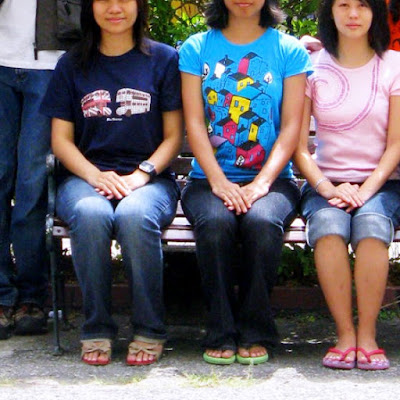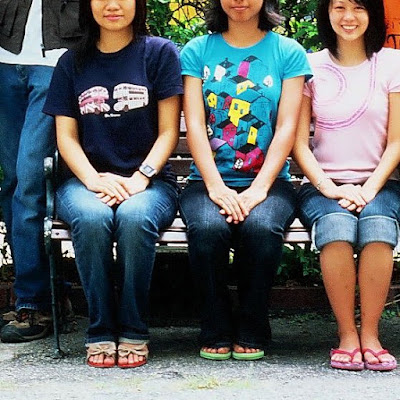Yen wrote about it very promptly, here. My side of the story will be coming very soon.
Meanwhile, I was looking through the pictures, and realised Ken Rockwell is right about a few things when it comes to the film-digital divide.
I'm comparing the following pictures, one shot on film and scanned in at about 2.7 megapixels, the other shot at 5.0 megapixels on a Canon Powershot digital compact camera.
The pictures have not been edited beyond very mild brightness adjustments and square cropping.
In this comparison, I will ignore exposure, i.e. brightness, as they were shot at different settings. But there are a few little elements which are consistent from digital compact to digital SLR, and these are the ones I will discuss.
Big Picture
.jpg)
d'NAers in front of Desa Inn, Kuala Pilah. Canon Powershot A720 IS.
.jpg)
d'NAers in front of Desa Inn, Kuala Pilah. Nikon FM10 with 50mm f1.8 lens, Fujichrome Velvia 50.
Dark Colours

Digital.

Film.
Notice that there is noise on David's navy T-shirt in the digital shot, and grain in the film. Velvia 50 is a practically grainless film, and the grain is visible only because this is a 100% crop from a low-resolution 2.7 megapixel scan. In fact, Velvia can be scanned up to 24 megapixels on a good scanner.
But the point is that grain does not affect colour fidelity, unlike noise, which throws in random bits of colour in dark areas of a photograph. This is common in pictures shot under low light, but should not happen in a photo taken in broad daylight, such as this.
Digital SLRs, because of their larger sensors (compared to digital compacts), are able to better maintain the integrity of dark areas, but as this test shows, even the best digital SLRs have their limitations.
Film, on the other hand, knows no bounds because it does not rely on individual pixels to relay information. (Go look up Bayer interpolation to know why digital will always be one or more steps behind.)
Colours and Highlights

Digital.

Film.
First, colour. The Powershot was set to Vivid mode (Yen's default), and Velvia is always vivid. But notice that while Ming's T-shirt is a lot more saturated (bright orange) in the digital picture than in the film, the red lanterns in the background are more saturated in the film.
Film has more even colour saturation, though digital SLRs do come a lot closer than digital compacts.
Second, highlight control. In the digital shot, there is a greater disparity between the dark areas (shophouse shutters) and bright areas (e.g. Alissa's left shoulder) than in the film shot.
Once again, a digital SLR would have done a better job in maintaining the highlights (really bright areas) while bringing out the shadows. But nothing tops film.
Sharpness and Detail

Digital.

Film.
Look at the jeans and slippers. I rest my case. There is so much more detail, texture and depth in the film shot.
Digital (whether SLR or compact) always looks cleaner because it cheats on noise. Most modern digital cameras employ noise reduction, which gets rid of the coloured bits of noise in dark areas. However, this also wipes out the texture that was on the original subject.
Film has no noise reduction, because it has no noise to begin with. Film is comprised of photosensitive crystals which appear as grain, and grain always keeps the texture in there. It is the equivalent of art block in watercolour painting, which always has a rougher texture than inkjet prints of billboard advertisements and movie posters.
Digital always has a more two-dimensional, cartoon-y look, while film is a lot more three-dimensional. This is not at all to say that digital is worse than film; they are different media in the same way that watercolour and oil are different media.
In our digital inkjet age, clean, crisp photographs are held to be the standard. But as someone with an art background, I seek more texture and punch in my photographs; something film never fails to deliver, and digital cannot.
So what am I against? Digital photography? Not at all. I own and shoot a digital SLR, and I still love it.
What I find hilarious are the countless advertisements that seemingly assert the superiority of the latest digital SLR or compact over all prior models. What they don't disclose is that film has always been way superior in terms of technical quality; digital only makes things more convenient, especially for amateurs like myself who are wont to make mistakes.
Go ahead, shoot digital; it's a whole lot more fun. But once in a while, it's nice to pop a couple of rolls of film, if only to be reminded of what photography was, and is, in the first place.
2 comments:
Vivid mode is and has not been my default since Tim told me not to, and that was a long, long time ago. If at Desa Inn you set it to Vivid, then I dunno, but it's certainly not my default.
i thought velvia cannot be used for people coz of the high colour saturation?
Post a Comment